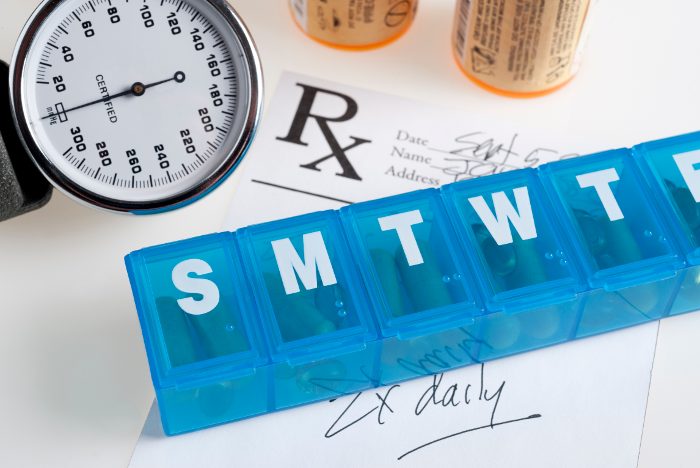Prescription Drug Plan (Part D)
Medicare Part D (Prescription Drug Coverage)
Medicare prescription drug coverage is an optional benefit offered to everyone who has Medicare. If you decide not to get Medicare drug coverage when you’re first eligible, you’ll likely pay a late enrollment penalty if you join later, unless one of these applies:
- You have other creditable prescription drug coverage
- You get Extra Help
Generally, you’ll pay this penalty for as long as you have Medicare prescription drug coverage. To get Medicare drug coverage, you must join a Medicare plan that offers prescription drug coverage. Each plan can vary in cost and drugs covered.

Two ways to get prescription drug coverage
- Medicare Prescription Drug Plan (Part D) . These plans (sometimes called “PDPs”) add drug coverage to Original Medicare, some Medicare Cost Plans, some Medicare Private Fee-forService (PFFS) Plans, and Medicare Medical Savings Account (MSA) Plans.
- Medicare Advantage Plan (Part C) (like an HMO or PPO) or other Medicare health plan that offers Medicare prescription drug coverage. You get all of your Medicare Part A (Hospital Insurance) and Medicare Part B (Medical Insurance) coverage, and prescription drug coverage (Part D), through these plans. Medicare Advantage Plans with prescription drug coverage are sometimes called “MA-PDs.” You must have Part A and Part B to join a Medicare Advantage Plan.
Joining a Medicare drug plan may affect your Medicare Advantage Plan
Your Medicare Advantage Plan (Part C) will disenroll you and you’ll go back to Original Medicare if both of these apply:
- Your Medicare Advantage Plan includes prescription drug coverage.
- You join a Medicare Prescription Drug Plan (Part D)
Request a Quote
FAQs
-
What is Medicare Part D prescription drug insurance?
Medicare Part D is a prescription drug insurance program offered by the U.S.
government. It provides coverage for prescription medications and helps Medicare
beneficiaries pay for the cost of their prescription drugs. -
Who is eligible for Medicare Part D?
To be eligible for Medicare Part D, you must be enrolled in either Medicare Part A or
Part B. You must also live in the service area of a Medicare Part D plan. -
When can I enroll in Medicare Part D?
You can enroll in Medicare Part D during the Initial Enrollment Period (IEP), which is
the seven-month period that starts three months before your 65th birthday month,
includes your birthday month, and ends three months after your birthday month. You
can also enroll during the Annual Enrollment Period (AEP), which occurs from October
15 to December 7 each year. -
What happens if I don't enroll in Medicare Part D when I'm first eligible?
If you don't enroll in Medicare Part D when you're first eligible and you don't have
other creditable prescription drug coverage, you may have to pay a late enrollment
penalty if you decide to enroll at a later date. The penalty is added to your monthly
premium for as long as you have Medicare Part D coverage. -
How do I choose a Medicare Part D plan?
To choose a Medicare Part D plan, you should consider factors such as the cost of
premiums, deductibles, and copayments, the specific medications you take and whether
they are covered by the plan, the network of pharmacies, and the overall quality of the
plan. You can use the Medicare Plan Finder tool on the official Medicare website to
compare different plans based on your specific needs. -
Can I switch Medicare Part D plans?
Yes, you can switch Medicare Part D plans during the Annual Enrollment Period (AEP)
from October 15 to December 7 each year. You can also switch plans if you qualify for a
Special Enrollment Period (SEP) due to certain life events, such as moving to a new area
or losing creditable drug coverage. -
Are all prescription drugs covered under Medicare Part D?
Medicare Part D plans are required to cover a wide range of prescription drugs. Each
plan has its own formulary, which is a list of covered drugs. It's important to review the
formulary of the plan you're considering to ensure that the medications you need are
covered. -
How much does Medicare Part D cost?
The cost of Medicare Part D can vary depending on the specific plan you choose.
Costs include premiums, deductibles, copayments, and coinsurance. It's important to
compare different plans to find one that suits your budget and medication needs. -
Can I get extra help paying for Medicare Part D?
Yes, there are programs available that provide extra help paying for Medicare Part D
costs for individuals with limited income and resources. The Extra Help program, also
known as the Low-Income Subsidy (LIS), can assist with premiums, deductibles, and
copayments. You can apply for Extra Help through the Social Security Administration. -
How do I enroll in Medicare Part D?
To enroll in Medicare Part D, you can either contact plans directly, call
1-800-MEDICARE, or visit the official Medicare website. During the enrollment process,
you will need to provide information about your Medicare card, personal details, and the
medications you currently take.